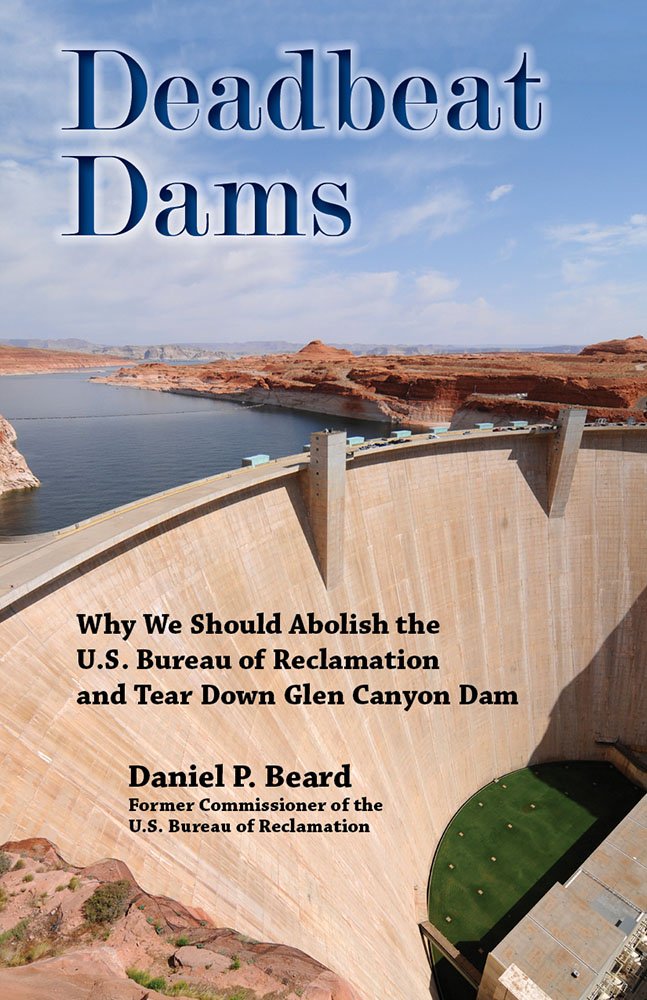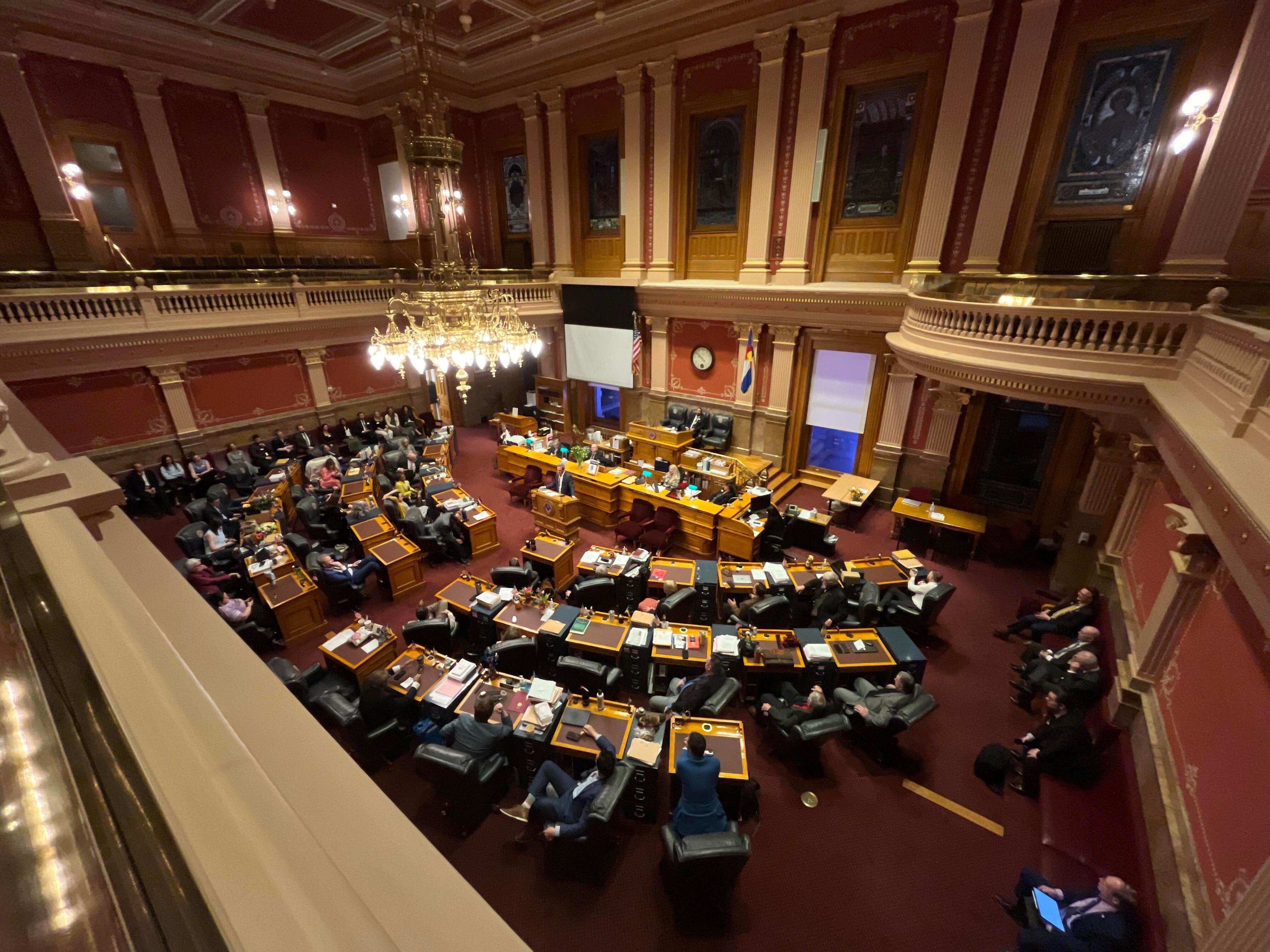
Dan Beard served as commissioner of the U.S. Bureau of Reclamation for two years under President Bill Clinton. He now believes the federal agency, best-known for its massive western water projects, should be abolished.

Beard argues his case in a new book, “Deadbeat Dams: Why We Should Abolish the U.S. Bureau of Reclamation and Tear Down Glen Canyon Dam.”
"America is facing a water crisis and nowhere is this more evident than in the West where significant problems abound," he writes. "The western United States is struggling to survive a fifteen-year drought that is the worst in nearly a thousand years."
Beard pinned much of the blame on federal subsidies to agriculture. He said while farming has become more efficient, it still wastes a "monumental" amount of water because subsidies disincentive improvements.
Beard spoke with Colorado Matters host Ryan Warner. Here are highlights from their conversation.
On the importance of local control
"It's a great agency with a proud history. And I was proud to be the commissioner of the Bureau of Reclamation. But times and conditions change, and I think it's time we allow leadership for solving Western water problems to reside with the individual states, communities and regional entities that can do a better job than having the federal government step in."
On agriculture subsidies
"We heavily subsidize the delivery of water to agricultural interests in the West from federal facilities. What do I mean by that? I mean it costs us $100 to deliver an acre foot of water and we charge the farmers $2. Who picks up the other $98? And the answer is, it's you and me. Generally, the water that is delivered to communities throughout the West, throughout the nation is not subsidized to the extent that it is for agriculture."
On what should be done
"The single most-important change that we can make is to eliminate subsidized water. We will permanently alter the water world for the better if we do that. Policy makers at every level, that means local, state and federal level, have to begin to accept the principle that those who want to use a scarce resource like water should pay the full cost."
On the "myth" of scarcity
"Every study that's undertaken shows that there is enough water. Problem is that it's just distributed incorrectly. And once you start pricing it, you will stop wasting it."
On the lack of innovation
"It is the most uncreative field I can think of. I mean, we sent men to the moon, put cell phones in the hands of billion of people across the globe, and yet ... the primary things we're using to deliver water are surface storage and gravity. At some point we're going to wake up and adapt new technology and new tools and new ideas to the delivery of water. And I think the key to that is when it's priced correctly."
The bureau declined CPR's request for a response.
Read an excerpt
Reprinted from “Deadbeat Dams: Why We Should Abolish the U.S. Bureau of Reclamation and Tear Down Glen Canyon Dam,” by Daniel P. Beard. Copyright 2015 by Johnson Books, a Big Earth Publishing company. Prelude: If the Taxpayers Only Knew “What a waste, what a colossal waste. The taxpayers would be outraged if they knew what was really going on here,” I thought to myself. It was nearly ten years ago and I was sitting on the dais looking out at the people attending a meeting of the Colorado River Water Users Association. The association had gathered for their annual meeting amid the fake opulence of Caesars Palace in Las Vegas. They had asked five former commissioners of the U.S. Bureau of Reclamation, including myself, to reflect on our tenure directing the federal agency responsible for building and operating water projects across the West, such as Hoover, Glen Canyon, and Grand Coulee Dams. This minor agency of fifty-five hundred employees had had an indelible impact on the West. By building dams and canals, the agency had provided subsidized water and electric power to farms and cities across the West for just over a hundred years. The Bureau of Reclamation had been instrumental in the growth of cities like Los Angeles, Las Vegas, and Phoenix, the development of agriculture in California’s Central and Imperial Valleys, and many other parts of the West. But there was another side to the agency’s history. These projects also destroyed hundreds of miles of free-flowing rivers, promoted excessive water use, and sent billions of dollars in subsidies to a small number of people—many of whom sat in the audience at Caesars Palace. The agency had outlived whatever usefulness it had and now needed to be abolished. Some of its trademark facilities, such as Glen Canyon Dam, needed to be removed to meet contemporary water needs. I had prepared a polite set of non-controversial remarks for the event. But as I sat there observing the people in the audience and listening to the other speakers, it occurred to me that the public deserved to learn what was really going on. I set aside my remarks and spoke from the heart. I explained that we’re lavishing billions of dollars of federal taxpayer money on a small group of people who have come to think of this money as an entitlement. This arrangement is preserved by a complicit Congress and an out-of-date federal bureaucracy. Billions of gallons of water are being wasted by growing crops we don’t need. We think nothing of drying up rivers, killing fish, and destroying tourism so that a hobby farmer can grow hay for his daughter’s horse. We promote water waste on a massive scale under the mistaken impression that water should be treated as a “free” commodity. We’re repeating failed approaches to solving problems that will have reached crisis proportions. Facilities built to meet spurious needs identified in the nineteenth and early twentieth centuries are out of date and need to be removed. As I finished my remarks, I looked out at the crowd and there seemed to be two emotions etched on their faces. Some of the people had raised eyebrows and a “did-he-just-say-what-I-thoughthe- said?” look. The rest of the crowd had deep furrowed brows, and if looks could kill, I would have been a dead man. As I left the dais, a young lady from a water education group approached. With cynicism dripping from every word, she said: “Well, you’re still as controversial as ever.” I took her comment as a compliment. When I returned from Las Vegas, I threw myself into the task of finding someone to write a book about the need to change western water policies. I wanted to expose the public to the lack of common sense, corruption, and utter waste I had witnessed over a long government career and propose a series of reforms. Despite my best efforts, I couldn’t find any takers. If someone was going to write that book, I was going to have to do it. This certainly isn’t a new subject to me. For almost forty years, I worked in a variety of professional capacities on water policy issues. I was involved in one way or another in most major western water policy debate or legislation during that period. I had been a non-profit advocate, consultant, government administrator, political appointee under two Presidents, chief of staff to a U.S. senator, and staff director for a congressional committee. I remember thinking at a particularly boring congressional hearing I attended in the House of Representatives that I had sat in every chair in the room. I had sat in the audience, at the witness table, behind the members of Congress passing questions, and at the dais asking questions of witnesses. But it wasn’t until my emotions got the best of me in Las Vegas that I even considered writing a book on the subject. Debates about western water are the stuff of legends. Almost everyone has heard the saying attributed to Mark Twain that in the West, “Whiskey is fer drinking, and water is fer fightin’.” Murders, gunfights, lawsuits, demonstrations, and ferocious political battles have all been part of western water debates. Hundreds of books have been written, thousands of websites created, and miles of column inches in newspapers have chronicled activities for over a century. What could I say that would add to this subject? While a great deal has been written, I had always felt that authors were pulling their punches. They weren’t being completely candid with their readers. They weren’t telling the real story of western water. Someone who had been on the “inside” of the system needed to expose it. America is facing a water crisis and nowhere is this more evident than in the West where significant problems abound. At this writing, the western United States is struggling to survive a fifteen-year drought that is the worst in nearly a thousand years. One scientist called it a “megadrought.” “Bathtub rings” now circle Lake Mead, America’s largest reservoir, because the lake is now half empty. Water levels in reservoirs across the West have dropped to record lows. As of August 2014, 100 percent of California was considered in a drought. Water and power shortages are now a real possibility for Las Vegas, Phoenix, Los Angeles, and other major western cities. The megadrought will start to rattle through the national economy if these trends continue, causing food prices to rise and impacting our national economy to the tune of billions of dollars. How are we responding to this growing crisis? We’re not. Our leaders appear to be ostriches with their heads stuck in the ground. Government agencies spend millions of dollars on studies that find new ways to restate the obvious. Government officials scurry from meeting to meeting desperately searching for painless “solutions,” which give the appearance of addressing problems without doing so. Politicians are in denial and everyone avoids hard choices. None of this should surprise us. We’ve known the megadrought was coming for years. Scientists and even governmentchartered commissions have predicted our drought “malaise.” Despite bold and sometimes career-threatening predictions by some scientists, our government officials and their parasitic supplicants have squelched any effort to begin to address these problems. They have established slick public relations campaigns with alliterative titles designed to delay any effort to make a decision. The George W. Bush Administration created the “Water 2025” campaign to avoid today’s problems and not be prepared for tomorrow’s. The Obama Administration isn’t much better. Their solution is for us to become “WaterSMART” by awarding grants to their friends and ignoring their critics. Why can’t our leaders face reality and begin to address these issues? They’re not willing to identify and tackle the root cause of the West’s present water problems because we have allowed a small group of individuals and organizations, whom I refer to as the “Water Nobility,” to receive billions of dollars in subsidies and to control western water policy. The Water Nobility feels it is a birthright to which they are entitled. Taxpayers should continue to take money out of their wallets and give it to the Water Nobility. They keep the public uninformed. They squelch creativity, ignore common sense, and perpetuate myths. All the while, they line their pockets with taxpayer dollars and demand even more money. The American public should know how their tax dollars are being used to enrich this small group of western water interests. The Water Nobility is pampered and coddled by a willing Congress and federal bureaucracy. The Nobility has come to view the benefits they receive from the taxpayers as just and appropriate. If we don’t force them to release their grip, the Water Nobility will continue to line their own pockets with billions of dollars in federal subsidies and payments for another fifty to a hundred years, the megadrought will continue, western rivers will continue to suffer damage, and economic progress in many regions will be threatened. Within the last decade, a series of disturbing developments have added to the urgent need to reform this system. Not content with wasting tens of millions of tax dollars on wasteful water projects, members of Congress and state legislators are still proposing billions of dollars for new uneconomic and environmentally destructive water projects. They continue to pass legislation enriching a few people to the tune of hundreds of millions of dollars. The megadrought in the West has grown in severity and threatens to have a national impact. Climate change is altering rainfall and precipitation patterns, and we are just now realizing that this will force us to completely re-think how we manage water resources. A renewed effort is being made by some national politicians to attack scientists because they don’t like the answers they receive on many fundamental questions, including water issues. Scientists are called on the carpet before congressional committees while other scientists are having their agencies abolished. When I began writing this book, I thought that if people learned what was going on, they would be outraged, and that outrage would lead to reform. But I soon realized outrage by itself leads nowhere. What we need are concerned people who are armed with an agenda for reform. Outrage can lead to action, but those actions need to be channeled in the right direction. The purpose of this book is to inform and educate people about how their tax dollars are being used and misused, why we are ignoring some immediate problems, and what can be done to correct this state of affairs. In the pages that follow, the faults of the present system of federally assisted water management efforts will be amply detailed. But a series of specific changes will be recommended to re-direct water policy decision-making and implementation. These reforms will loosen the grip of the Water Nobility and improve the decisions made in Congress and the federal bureaucracy and states on water matters. These reforms show how we can extract the federal government from worthless activities that cost millions and provide little or no benefit. The reforms will also lay out how and why we need to get prepared for a more uncertain future. Can one person laying out a reform agenda like this make a difference? Ten years ago, I had my doubts, but not today. A considerable amount has changed in the world of politics and public policy over the past decade. It used to be that those seeking reform were forced to write and publish a tome and hope that someone in a position of influence would read it. Maybe congressional hearings might be held. Maybe nongovernmental organizations would pick up the elements of a reform agenda and assist in marketing the effort. Maybe, maybe, maybe. But with the rise of the Internet and social media, a single individual with a compelling agenda can make a difference. We now have the ability to target and send information to thousands of people with the stroke of a keyboard. The WikiLeaks episode and the National Security Agency disclosures of Edward Snowden aptly demonstrate what one individual can do with compelling information. No matter what the morality of these episodes, they show that information is power, and when millions of people become aware of that information, change can and does occur. During this same period, our political ethos has also changed. The new electronic media generation and many taxpayers feel that they have a “right to know” how the system works, and what those in a position of power are doing with their tax dollars. They want to know what is being withheld from them, and they no longer have to wait for organizations or governments to blow the whistle or divulge information. Now, any individual with a smart phone or a blog is capable of shining the bright light of public opinion on outrageous practices and policies. Creating a “buzz” or getting an idea to go “viral” is not easy. But it is possible if people know the facts and they’re armed with an agenda for change. It is for this reason that I have written this book. I want to lay out the issues, and more important, lay out an agenda for reform that can be used as ammunition by a new generation of water reformers. |







